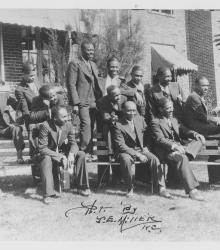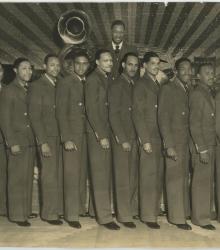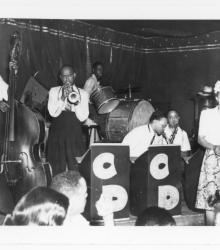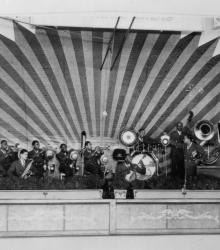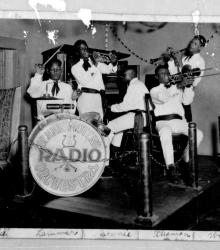Harlan Leonard once described N. Clark Smith’s impressive persona as the segregated Lincoln High School’s band leader in Kansas City, saying that Major Smith held a “commanding personality”: “He was short, chubby, gruff, military in bearing, wore glasses, and was never seen without his full uniform and decorations. His language was rather rough and occasionally shocking to the few young ladies who were taking music classes, though never offensive. Major Smith simply ran a tight ship. . . . He drilled the Lincoln marching bands until they were the best in the area, some said the best of their kind in the Middle West.”
Washington, Booker
Photograph of Bennie Moten's Orchestra posed outside. Pictured left to right: are Jimmy Rushing, Jack Washington, Woodie Walder, Count Basie, Leroy Berry, Bus Moten, Eddie Durham, Willie McWashington, Vernon Page, Thamon Hayes, Harlan Leonard, Ed Lewis, Booker Washington, Bennie Moten.
1932 photograph of Thamon Hayes’ Kansas City Rockets group posed in front of the Fairyland Park stage at the southeast corner of Prospect Avenue and 75th Street. From left: Ed Lewis, Baby Lovett, Jesse Stone, Richard Smith, Herman Walder, Thamon Hayes, Vic Dickenson, Woodie Walder, Harlan Leonard, Booker T. Washington, Vernon Page.
Band at Chauncey Down's Hall includes Herman Walder, Booker Washington, Walter Page, no date. Chauncey Down's Hall (known later as the Casa Loma Ballroom) was located in the Downs Building at the southeast corner of 18th Street and Prospect Avenue, ca. 1940. Source: Herman Walder.
Thamon Hayes’ Rockets on stage at Fairyland Park, ca. 1930. Fairyland Park was located at the southeast corner of Prospect Avenue and 75th Street.
On September 23, 1923, the Bennie Moten Orchestra made its first recording consisting of eight songs. By strict musical standards, the songs themselves were unrefined and not much removed from existing blues music. But the Bennie Moten Orchestra would soon build upon its earliest recordings to develop a distinct Kansas City style of jazz that later dominated the jazz scene in the late 1930s and 1940s.

